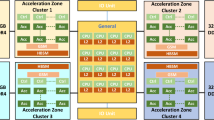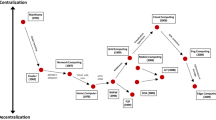Abstract
Numerous studies show that miss ratios at forward proxies are typically at least 40–50%. This paper proposes and evaluates a new approach for improving the throughput of Web proxy systems by reducing the overhead of handling cache misses. Namely, we propose to front-end a Web proxy with a high performance node that filters the requests, processing the misses and forwarding the hits and the new cacheable content to the proxy. Requests are filtered based on hints of the proxy cache content. This system, called Proxy Accelerator, achieves significantly better communications performance than a traditional proxy system. For instance, an accelerator can be built as an embedded system optimized for communication and HTTP processing, or as a kernel-mode HTTP server. Scalability with the Web proxy cluster size is achieved by using several accelerators. We use analytical models, trace-based simulations, and a real implementation to study the benefits and the implementation tradeoffs of this new approach. Our results show that a single proxy accelerator node in front of a 4-node Web proxy can improve the cost-performance ratio by about 40%. Hint-based request filter implementation choices that do not affect the overall hit ratio are available. An implementation of the hint management module integrated in Web proxy software is presented. Experimental evaluation of the implementation demonstrates that the associated overheads are very small.
Similar content being viewed by others
References
Alteon Web Systems, ACEdirector Web Switch, http://www. alteonwebsystems.com/products/acedirector2-data.shtml (1999).
M. Aron, D. Sanders, P. Druschel and W. Zwaenepoel, Scalable content-aware request distribution in cluster-based network servers, in: Proc. Annual Usenix Technical Conference (2000).
P. Barford, A. Bestavros, A. Bradley and M. Crovella, Changes in Web client access patterns. Characteristics and caching implications, World Wide Web Journal, Special Issue on Characterization and Performance Evaluation 2(1- 2) (1999).
A. Bestavros, M. Crovella, J. Liu and D. Martin, Distributed packet rewriting and its application to scalable server architectures, in: Proc. 6th Int. Conf. on Network Protocols (1998).
B. Bloom, Space/time trade-offs in hash coding with allowable errors, Communications of ACM 13(7) (1970) 422–426.
P. Cao and S. Irani, Cost-aware WWW proxy caching algorithms, in: Proc. USENIX Symp. on Internet Technologies and Systems (1997).
B.M. Duska, D. Marwood and M.J. Feeley, The measured access characteristics ofWorld-Wide-Web client proxy caches, in: Proc. USENIX Symp. on Internet Technologies and Systems (1997).
L. Fan, P. Cao, J. Almeida and A.Z. Broder, Summary cache: A scalable wide-area Web cache sharing protocol, in: Proc. SIGCOMM'98 (1998).
A. Feldmann, R. Caceres, F. Douglis, G. Glass and M. Rabinovich, Performance of Web proxy caching in heterogeneous bandwidth environments, in: Proc. IEEE INFOCOM'99 (1999).
S. Gadde, J. Chase and M. Rabinovich, A taste of crispy squid, in: Proc. Workshop on Internet Server Performance (1998).
S.D. Gribble, UC Berkeley Home IP HTTP Traces, http://www.acm. org/sigcomm/ITA (1997).
S.D. Gribble and E.A. Brewer, System design issues for Internet middleware services: Deductions from a large client trace, in: Proc. USENIX Symp. on Internet Technologies and Systems (1997).
A. Heddaya, DynaCache: Weaving caching into the Internet, in: Proc. International Web Caching Workshop (1998).
E. Johnson (ArrowPoint Communications), Increasing the performance of transparent caching with content-aware cache bypass, in: Proc. International Web Caching Workshop (1999).
E. Levy, A. Iyengar, J. Song and D. Dias, Design and performance of a Web server accelerator, in: Proc. IEEE INFOCOM'99 (1999).
IBMNetfinity Web Server Accelerator V2.0, http://www.pc.ibm.com/ us/solutions/netfinity/server_accelerator.html (2000).
V. Pai, M. Aron, G. Banga, M. Svendsen, P. Druschel, W. Zwaenepoel and E. Nahum, Locality-aware request distribution in cluster-based network servers, in: Proc. Int. Conf. on Architectural Support for Programming Languages and Operating Systems (1998).
A. Rousskov and V. Soloviev, A performance study of the squid proxy on HTTP/1.0, WWW Journal 1(2) (1999).
A. Rousskov and D. Wessels, Cache digests, http://squid.nlanr.net/ Squid/CacheDigest (1998).
A. Rousskov and D. Wessels, High performance benchmarking with Web polygraph, http://ircache.nlanr.net/Polygraph/doc/papers/ paper01.ps.gz (1999).
J. Song, E. Levy, A. Iyengar and D. Dias, Design alternatives for scalable Web server accelerators, in: Proc. IEEE Int. Symp. on Performance Analysis of Systems and Software (2000).
R. Tewari, M. Dahlin, H.M. Vin and J.S. Kay, Beyond hierarchies: Design considerations for distributed caching on the Internet, in: Proc. Int. Conf. on Distributed Computing Systems (1999).
A. Wolman, G.M. Voelker, N. Sharma, N. Cardwell, A. Karlin and H.M. Levy, On the scale and performance of cooperative Web proxy caching, in: Proc. ACM Symp. on Operating Systems Principles (1999).
Author information
Authors and Affiliations
Rights and permissions
About this article
Cite this article
Roşu, D., Iyengar, A. & Dias, D. Web Proxy Acceleration. Cluster Computing 4, 307–317 (2001). https://doi.org/10.1023/A:1011864611460
Issue Date:
DOI: https://doi.org/10.1023/A:1011864611460




